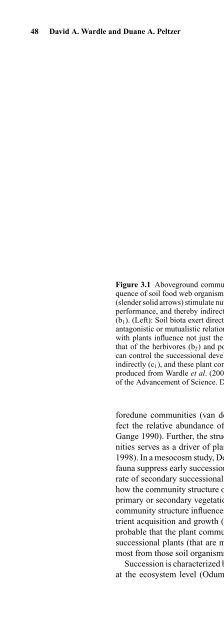Linking Restoration and Ecological Succession (Springer ... - Inecol
Linking Restoration and Ecological Succession (Springer ... - Inecol
Linking Restoration and Ecological Succession (Springer ... - Inecol
You also want an ePaper? Increase the reach of your titles
YUMPU automatically turns print PDFs into web optimized ePapers that Google loves.
48 David A. Wardle <strong>and</strong> Duane A. Peltzer<br />
Figure 3.1 Aboveground communities as affected by both direct <strong>and</strong> indirect consequence<br />
of soil food web organisms. (Right): Feeding activities in the detritus food web<br />
(slender solid arrows) stimulate nutrient turnover, plant nutrient acquisition (a), <strong>and</strong> plant<br />
performance, <strong>and</strong> thereby indirectly influence aboveground herbivores (broken arrow)<br />
(b1). (Left): Soil biota exert direct effects on plants by feeding upon roots <strong>and</strong> forming<br />
antagonistic or mutualistic relationships with their host plants. Such direct interactions<br />
with plants influence not just the performance of the host plants themselves but also<br />
that of the herbivores (b2) <strong>and</strong> potentially their predators. Further, the soil food web<br />
can control the successional development of plant communities both directly (c2) <strong>and</strong><br />
indirectly (c1), <strong>and</strong> these plant community changes can in turn influence soil biota. Reproduced<br />
from Wardle et al. (2004a) with permission from the American Association<br />
of the Advancement of Science. Drawing by Heikki Setälä.<br />
foredune communities (van der Putten et al. 1993), <strong>and</strong> root herbivores affect<br />
the relative abundance of different plant functional groups (Brown <strong>and</strong><br />
Gange 1990). Further, the structure of arbuscular mycorrhizal fungal communities<br />
serves as a driver of plant community structure (Van der Heijden et al.<br />
1998). In a mesocosm study, De Deyn et al. (2003) showed that soil invertebrate<br />
fauna suppress early successional grassl<strong>and</strong> plant species <strong>and</strong> thus promote the<br />
rate of secondary successional change in vegetation. Less is understood about<br />
how the community structure of decomposer microbes <strong>and</strong> fauna affects either<br />
primary or secondary vegetation succession. However, given that decomposer<br />
community structure influences nutrient mineralization <strong>and</strong> therefore plant nutrient<br />
acquisition <strong>and</strong> growth (Laakso <strong>and</strong> Setälä 1999, Liiri et al. 2002), it is<br />
probable that the plant community composition is also responsive, with early<br />
successional plants (that are most dependent on mineral nutrients) benefiting<br />
most from those soil organisms that maximize soil mineralization.<br />
<strong>Succession</strong> is characterized by shifts not only at the community level but also<br />
at the ecosystem level (Odum 1969). Aboveground–belowground feedbacks

















